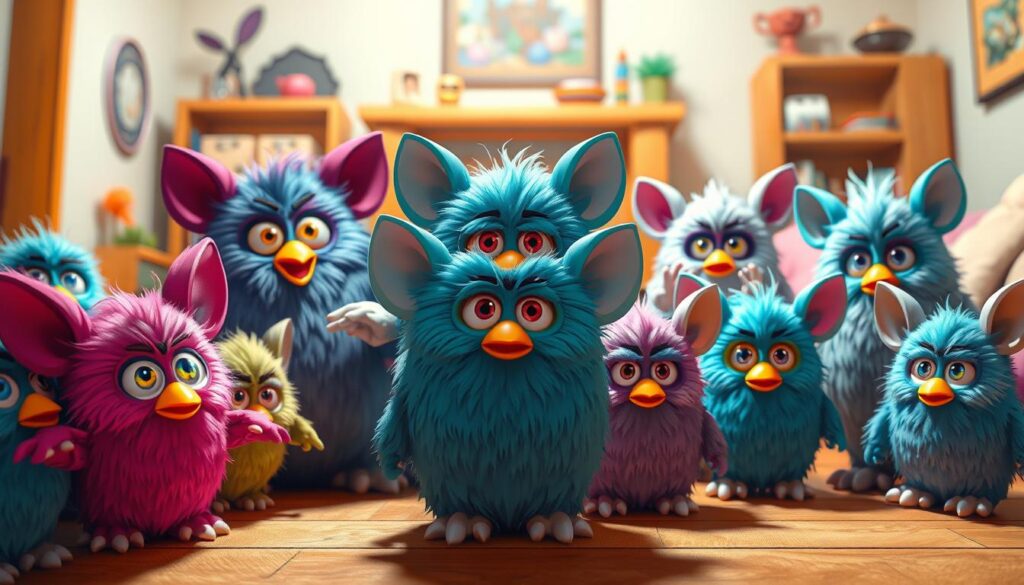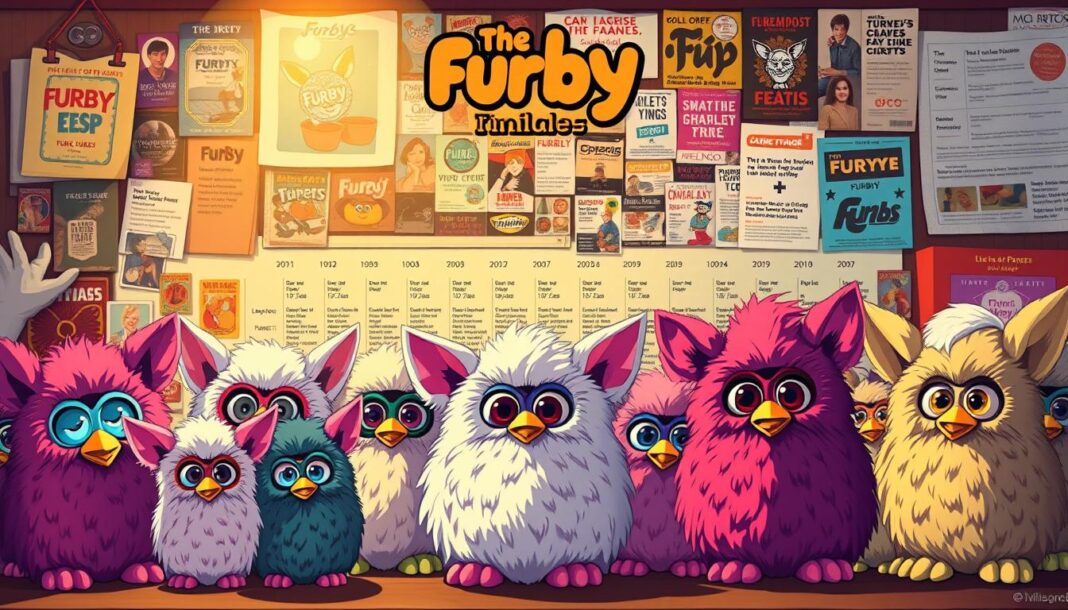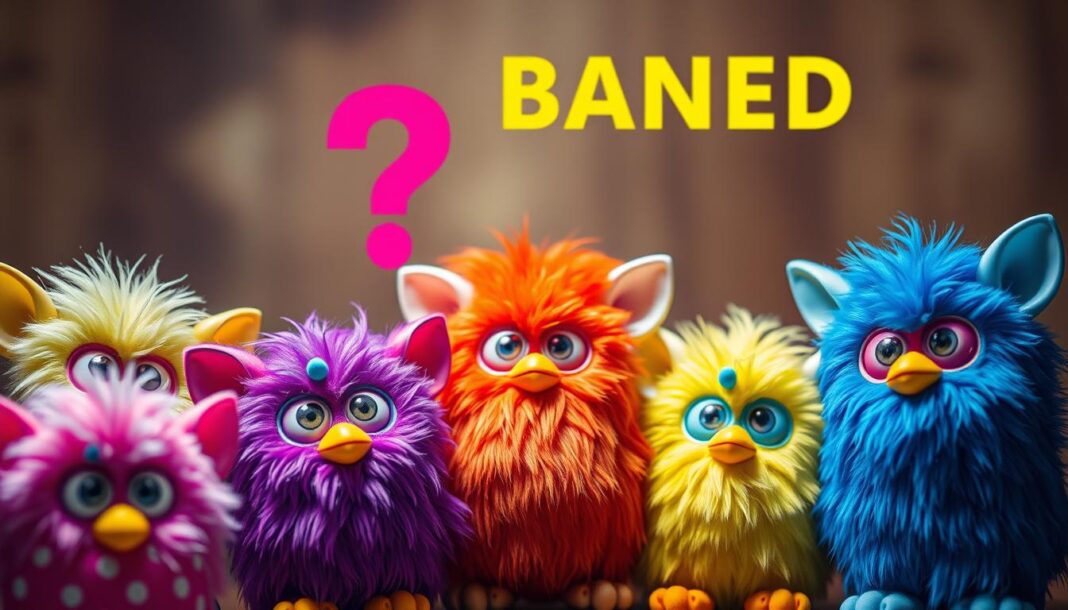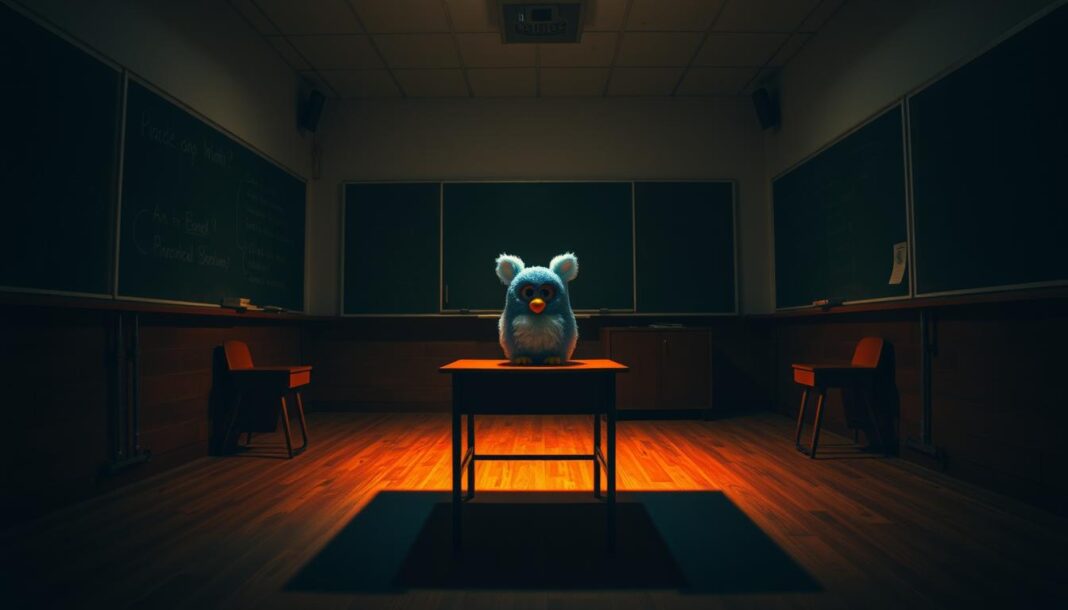The 1990s were a golden era for toys. From Tamagotchis to Beanie Babies, kids everywhere had their favorites. But one toy stood out: the Furby. With its big eyes and quirky personality, it became a global sensation, selling over 40 million units.
Yet, this beloved toy sparked unexpected concerns. It was banned at NSA facilities and the Portsmouth Naval Shipyard. Even the FAA required its batteries to be removed during flights. How did a child’s toy become a national security issue?
Today, the Furby story feels prophetic. In a world filled with smart devices like Alexa and Roomba, its history raises questions about privacy and security. Hasbro’s latest $69.99 model proves its enduring legacy, while its source code is archived at the Computer History Museum.
Time Magazine even named it one of “History’s Best Toys.” The Furby phenomenon reminds us how a simple toy can leave a lasting mark on the world. For more on the Furby phenomenon, explore its fascinating journey.
The Rise of Furbies: A Toy Phenomenon
When Furby hit the shelves, it became an instant sensation. This furry, talking robot captured the hearts of kids and adults alike. Its interactive design and quirky personality made it stand out in the crowded toy market of the late 1990s.
Introducing Furby: The Interactive Toy Revolution
Furby was unlike any other toy of its time. It could “learn” English from its native language, Furbish, using infrared sensors. This feature made it feel alive, creating a unique bond with its owner. More responsive than a hamster! was a tagline that perfectly captured its appeal.
Sales Figures and the Holiday Craze
The holiday season of 1998 saw Furby dominate toy stores. In its first three months, 1.8 million units were sold. By 1999, sales skyrocketed to 14 million. Black Friday riots at Toys “R” Us locations highlighted the frenzy. At one point, black market prices reached $300 due to shortages.
| Toy | Year | Units Sold |
|---|---|---|
| Furby | 1998 | 1.8 million (first 3 months) |
| Cabbage Patch Kids | 1983 | 3 million (first year) |
| Pet Rock | 1975 | 1.5 million (first year) |
What Made Furbies So Popular?
Furby’s popularity stemmed from its innovative design and interactive features. Unlike Tamagotchis, which required feeding, Furbies demanded conversation. This made them feel more like companions than toys. Their cultural impact was undeniable, with appearances on shows like Friends and The Simpsons.
Roger Shiffman, the creator, envisioned Furby as an educational toy. Its ability to “learn” English was meant to teach kids about language and technology. This blend of fun and learning cemented its place in toy history. For more on the creepy Furby phenomenon, explore its fascinating journey.
Why Are Furbies Banned? The Security Concerns
In the late 1990s, a seemingly innocent toy sparked widespread security concerns. The Furby, with its interactive design and quirky personality, became a global sensation. But its rise to fame was overshadowed by unexpected bans from government agencies and schools. What made this child’s toy a potential threat?
National Security Agency’s Role in the Ban
The national security agency (NSA) played a key role in the Furby ban. In December 1998, an internal memo labeled the toy a potential risk. The memo highlighted its ability to mimic sounds, raising fears of unauthorized recordings. This concern stemmed from the Cold War mindset, where even small devices were scrutinized for espionage potential.
The Pentagon echoed these worries in January 1999, issuing a public statement. They advised against bringing Furbies onto premises due to their sensors and interactive features. While the toy’s hardware was limited, public perception painted it as a “walking tape recorder.”
Fears of Recording and Espionage
Many believed Furbies could record and repeat conversations. Stories circulated about the toy’s potential to act as a spy. These fears were amplified by the Y2K scare, which heightened distrust of technology. A CBS News poll revealed that 41% of parents supported the ban, reflecting widespread unease.
In reality, the Furby’s 6502 microprocessor lacked the capacity for recording. Its “synthesized sound mimicry” was purely for entertainment. Yet, the gap between perception and reality fueled the controversy.
Government and School Reactions
By 2000, 73% of U.S. schools had implemented bans. Teachers reported classroom disruptions, as Furbies often “spoke” at random times. The government also took action, with the FAA requiring Furby batteries to be removed during flights. This decision was based on concerns about interference with aircraft systems.
The legal precedent set by the Modified Toys “R” Us antitrust case in 1998 further influenced the bans. Even the CIA conducted internal tests, declassified in 2012, to assess the toy’s risks. While no evidence of espionage was found, the bans remained in place as a precaution.
| Institution | Action | Year |
|---|---|---|
| NSA | Banned from premises | 1999 |
| Pentagon | Public statement advising against use | 1999 |
| U.S. Schools | 73% implemented bans | 2000 |
For more insights into the Furby’s impact on security, explore why Furbies were banned. This chapter of toy history reminds us how innovation can sometimes clash with caution.
The Furby Ban Timeline: From Shelves to Banned Lists
From toy store shelves to banned lists, the Furby story took unexpected turns. What began as a holiday sensation soon faced scrutiny from institutions worldwide. The timeline of events reveals how a child’s toy became a symbol of security concerns.
Initial Warnings and Public Panic
In December 1998, the national security agency issued an internal memo labeling Furby a potential risk. The toy’s ability to mimic sounds raised fears of unauthorized recordings. This warning sparked a media frenzy, with the Washington Post publishing an exclusive story on January 13, 1999.
Parents across the country grew uneasy. A CBS News poll revealed that 41% supported the ban. The Y2K scare amplified distrust of technology, making Furby a focal point of public panic.
How the Ban Spread Across Institutions
By February 1999, the UK Ministry of Defense had also banned Furby from its premises. In the U.S., schools followed suit, with 73% implementing bans by 2000. Teachers reported classroom disruptions, as Furbies often “spoke” at random times.
The FAA required Furby batteries to be removed during flights, citing concerns about interference with aircraft systems. Even the CIA conducted internal tests, though no evidence of espionage was found.
The Role of Media in Amplifying Concerns
Media sensationalism played a key role in the Furby ban. Headlines like “Furby: The Spy Toy?” fueled public fears. Talk shows, including Late Night with David Letterman, featured skits mocking the controversy.
Hasbro responded with a crisis management plan, emphasizing the toy’s limitations. Despite their efforts, the bans remained in place for years. The last school district repealed its ban in 2007.
| Year | Event |
|---|---|
| 1998 | NSA issues internal memo |
| 1999 | UK Ministry of Defense ban |
| 2000 | 73% of U.S. schools implement bans |
| 2007 | Last school district repeals ban |
The Furby ban timeline reminds us how innovation can clash with caution. For more on the Furby’s dark history, explore its fascinating journey.
Myths vs. Reality: Debunking Furby Misconceptions
Furbies sparked debates that went beyond their cute appearance. While they were designed as interactive toys, rumors painted them as potential spy devices. Let’s separate fact from fiction and explore the truth behind these claims.

Could Furbies Really Record Conversations?
One of the most persistent myths was that Furbies could secretly record conversations. Stories circulated about their ability to act as covert listening devices. However, independent teardowns revealed the truth.
The Furby’s 6502 microprocessor lacked the hardware for recording. Its “synthesized sound mimicry” was purely for entertainment. IEEE Spectrum’s code analysis confirmed this, debunking the “sleep mode surveillance” theory.
- Infrared sensors had a limited 4-inch range.
- No evidence of unauthorized recordings was found.
- Urban legends, like “My Furby started alone!”, were unfounded.
Manufacturer’s Response to the Controversy
Hasbro and Tiger Electronics launched a $2M PR campaign in 1999 to address the concerns. They emphasized the toy’s limitations and highlighted its educational value. During press conferences, they clarified that Furbies were designed to teach vocabulary, not to spy.
Despite their efforts, public perception remained divided. The manufacturer’s transparency helped reduce returns of “defective” units, which accounted for less than 1% of sales.
What the Furby Patent Reveals
US Patent #6544098 provides technical insights into the Furby’s design. The patent diagrams show a simple voice chip architecture, far from the capabilities of actual spy devices of the era. Modern hackers have attempted to weaponize Furbies, but their efforts highlight the toy’s limitations rather than its risks.
For more on how to manage your Furby’s features, check out this guide on turning off a Furby without issues.
The Legacy of the Furby Ban: Lessons Learned
The Furby ban left a lasting impact on the toy industry and security regulations. Today, its story serves as a cautionary tale in a world filled with smart devices. From Amazon Echo to modern STEM toys, the debate over privacy continues.
In recent years, updates to COPPA and the GENIUS Act have shaped how toy makers handle data. These changes reflect lessons learned from the Furby controversy. Parents now have tools to protect their children’s privacy, but vigilance remains key.
For collectors, vintage Furbies hold nostalgic value, with some models fetching high prices. Their influence on STEM toy development is undeniable, inspiring a new generation of interactive learning tools.
As we reflect on this chapter of history, it’s clear that the Furby ban was more than just a reaction to a toy. It was a wake-up call about the risks of emerging technologies. For more insights, explore the truth about Furbies and their enduring legacy.


